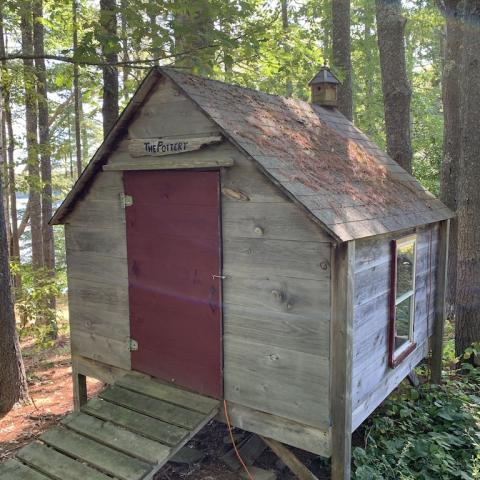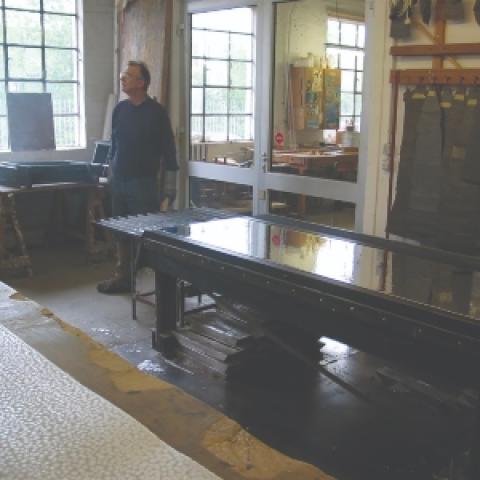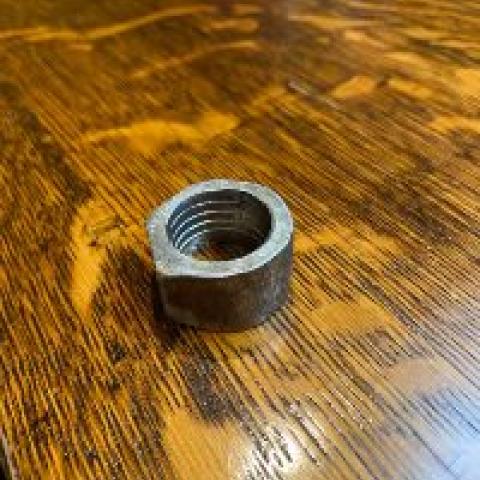
String too short to save
After my freshman year at Oberlin Conservatory of Music, I spent the summer working with Bozeman-Gibson & Company in Lowell, Massachusetts. It was 1975, and on my first day working in an organ shop, I was set up in the parking lot with sawhorses, a set of painted façade pipes, a can of Zip-Strip®, and a hose. If that wasn’t enough to send me running, I guess I was hooked. They were working on the restoration of an 1848 Stevens organ in Belfast, Maine, completing a new organ in Castleton, Vermont, and installing a rebuilt historic tracker (I do not remember the builder) in a Salvation Army chapel in Providence, Rhode Island. A lot of the summer was spent driving around New England between those organs, my first glimpse into the life of a vagabond organ guy.
During my sophomore year I started working part time for John Leek, the organ and harpsichord technician for the Oberlin Conservatory of Music. I spent the next summer working with Bozeman during which the company moved to their permanent workshop in Deerfield, Massachusetts. There were a couple hours of “barn building” each day after the organ building. I continued part time with Leek as long as I was a student and switched to full time after I graduated. Counting the summers and part-time work, I have been at it for forty-six years.
After Christmas of 2019 I retired from working on organs on site and in my workshop. No more weeks spent wiring organs, no more service calls, no more console rebuilds—my favorite workshop job. I hasten to add that I continue to run the Organ Clearing House, managing the sale of vintage organs, and keeping the crew busy. I am still working as a consultant and still writing monthly columns. They will have to snatch the MacBook® from my cold dead hands. I have not yet imagined a time when I would not be doing some type of work with pipe organs.
With the outbreak of Covid, Wendy and I left New York City for our place in Maine, bringing the families of two of our kids with us. My private workshop, the three-car garage, became a staging space for groceries for our expanded household as we quarantined everything we brought into the house. When winter turned to spring, we added a refrigerator beside the garage freezer. The workshop has always been at least part boatyard. I have a couple shelves of boat parts, the expensive stainless-steel screws we use around salt water, and there are several lengths of surplus line hanging on a wall. You never know when you are going to need some more line. It is also a gardening shed and kitchen overflow storage for the bigger pots and pans. Lobster pots, roasting pans, and canning jars live on the shelves above the fridge.
This sounds like a lot of clutter, but I still have not mentioned the cabinets, shelves, and industrial drawers full of organ parts and hardware I have accumulated over the years. One year I restored an Aeolian residence organ with its paper roll player. It was playable in the shop for a summer, and we had a string of dinner parties during which we would suggest a break before dessert and leave the table for an organ demonstration. Some of Wendy’s publishing friends and colleagues needed that to understand just what I do for a living. “It was always mysterious to me!” I have rebuilt four or five consoles here, refinishing cabinets, rebushing keyboards, and retrofitting solid-state controls and electric drawknobs.
I know I will keep most of the general hardware as long as we live here. It is handy to have hundreds of sizes of screws arranged in drawers to support home repair projects. This summer, I cut up several lengths of half-inch threaded rod and collected the necessary washers, nuts, and lock washers for a tool hanger I built in the shed. Mending plates, corner braces, and hinges will always come in handy. I have felt and punches to make pads for the bottoms of chair legs; I have lubricants and finishes for pretty much any purpose and big, well-lit workbenches. It is my own private hardware store. Funny, I still go to the hardware store most weeks.
He polished up the handle of the big front door.
Along with his organ work, John Leek built harpsichords, and as we made those keyboards and brass levers to control “choirs” of jacks, I learned about polishing. I have a bench grinder that spins abrasive wheels, wire wheels, and cloth polishing wheels. There is a drawer full of bars of polishing compound, a rake for dressing the cloth wheels, and the nasty wheel with an iron handle for dressing the abrasive wheels. I rejuvenated a rusty cast-iron skillet using the wire wheel. Handy.
There is a case of Parson’s sudsy ammonia on a high shelf. I think there are ten bottles left in it. It is a terrific solution for use in my ultrasonic cleaner. I have used it to clean reed shallots and tongues, little brass console parts like screws and switches. I will hang onto all this because there are lots of things around the house that need polishing, and Wendy’s engagement ring looks great after an ultrasonic swim in sudsy ammonia.
Totally tubular
I have worked on all sorts of pneumatic actions from different organ builders, many of which incorporate some type of rigid or flexible tubing. Seventy-year-old rubber tubing is likely to be crumbling apart. Quarter-inch (interior diameter) tubing is common to many different types of organs, so I have hundreds of feet of that in a coil, destined to be cut into six-inch pieces. There is about forty feet of three-quarter-inch (ID) heavy plastic tubing with nylon webbing embedded. It is made for high-pressure hot water in small gasoline engines, and it was great for use as pneumatic tubing in a big expression motor. I have coils of copper tubing and some straight lengths of aluminum and brass tubing. You never know when you are going to need some.
Parts is parts.
Sometime ago I got the idea that it would be clever to have a supply of the waxed boxes used for Asian carry-out food for storing specific organ parts. I used them for a while, decided they were ridiculous, and discarded most of the minimum order of 1,000 boxes, but some are still around. One is labeled “Schlicker console parts.” I installed a Peterson system in a Schlicker console. Having serviced many Schlicker organs over the years, I know that the little pressed metal toggles in the “ka-chunk” combination actions can wear and break or simply fall out, and here were two or three hundred of them going to waste. I used four or five for a service call repair, and I still have the rest of them. Pretty sure I am not going to need them again.
I have boxes of Austin magnets, Austin note motors, Kimber Allen keyboard contacts, pedalboard contacts, Heuss nuts, leather nuts, compass springs (for the pallets in slider windchests), pouch springs, fiber discs (for making pouches and valves), many sizes and styles of felt and paper punchings for regulating keyboards, and even coils of wire for stringing harpsichords.
For a short while I repaired and rebuilt harmoniums, and I have a heavy box full of the brass reeds. They must have been salvaged from derelict instruments. I do not remember where I got them, but I doubt I did the salvaging because I would have kept them separated and labeled by voices. I may have used ten of them, and the rest are here if anyone wants them. A soak in sudsy ammonia would help. Another box is full of keyboard ivories. I “harvested” them from old pianos and organ keyboards, and having a miscellany of ivories really is useful as you can pick through them to match color and size. While I used many of them for service call repairs and refurbishing old keyboards, I am probably finished with them now.
On the high shelf near the tubing, there is a stack of boxes of various types of windchest magnets. Some have pipe valves that work either electrically or pneumatically, others are the standard “screw cap” chest magnets for pitman and offset chests. And for those times when you are changing wind pressure, there are boxes of magnet caps with one-quarter-inch and three-sixteenths-inch exhaust holes. None of these will have household use.
There are about twenty three-foot cardboard tubes in the rafters containing skins of leather and yards of felt, fabric, and cork. There is enough material to releather a ten-stop pitman chest and a half-dozen reservoirs. There is pouch leather, gusset leather, alum-tanned leather for reservoir belts, and several types and weights of pneumatic leather. I am not sure how much of it I will use, but as I recently gave Wendy a big piece of thin black felt for a sewing project, I will assume it is worth keeping. Since it is up high, it is not in anyone’s way.
Twenty or thirty years ago, industrial chemists developed spray cans of graphite lubricant, perfect for treating windchest tables, sliders, and toeboard bottoms so slider stop action would work smoothly. Before switching to that, I mixed flake graphite with denatured alcohol creating a paste that I scooped with latex-gloved hands and rubbed over all the surfaces. It was a messy process, but when the alcohol evaporated, a rich, even coat of graphite glistened on the wood. Heaven help you if you spilled any on the floor. I have most of a gallon can of graphite that I guess I do not need anymore. I also have half a case of that graphite spray. I can use it on snow shovels to keep snow from sticking to them.
Material handling
In industrial catalogues, material handling is the section that includes dollies, carts, pallet jacks, and all the tools and equipment used to move things around. You can buy a Drum Dolly, a two-wheeler designed specifically to handle 55-gallon drums or a refrigerator dolly—you can guess what that’s for. A refrigerator dolly is a two-wheeler with straps to hold the load in place, and rubber belts that move over wheels on the back so you can haul the fridge up stairs. I have used mine for hauling reservoirs upstairs to choir lofts. The upright freezer in the garage needs to be defrosted occasionally. That can be a nasty job, but it is pretty simple here, and we have been “eating it down” in preparation. Soon, I will move the last few things into the top of the Covid fridge, wheel the freezer through the overhead door, and stand it in the dooryard facing the sun with the door open. It takes a few hours, and there is no need to catch the water.
I have a come-along, a tool with a steel cable, hooks on both ends, and a long handle that pumps a ratchet. I bought it when we were installing an organ and realized it needed to be a few inches to the left. A half-dozen pumps of the handle was all it took to scootch the organ to its proper place. I have not used it on a job since, but we have a half-mile wooded driveway that trees fall on occasionally. I can often hitch a chain to loops on my car and drag a tree out of the way, but several times I have used the come-along tied to another tree to do the job when I cannot make the angle with the car. We also use it to pull the dock out of the water. I am keeping that.
The opposite of the come-along is a house jack that I have used often when releathering reservoirs. After the hinges are glued to the ribs, the pairs of ribs are glued to the body and top, and the belts are glued on all around, you have to open the thing fully before gluing on the gussets. You are stretching all the new material and glue, and it can be a heavy lift, especially on a large reservoir. I have done it with blocks and levers, but a hand-pumped hydraulic house jack is just the ticket. When our daughter wanted to convert a small shed into a pottery studio, our son-in-law and I jacked up the shed and repaired its structure. I will keep the jack.
Another tool I used when gluing reservoirs is the big double-boiler you see keeping soup warm in a cafeteria line. Having hot wet rags is essential when using hot glue, and I have a Sharpie mark on the front for the little volume knob, setting the temperature high enough to soften excess glue, but not so hot that I cannot put my hands in it. When I was gluing four or five reservoirs at once, the pot would be hot all day, and I would change the water every hour as it got dark with the glue. We like to give big parties, and a steaming pot of clam chowder would be just the thing for a chilly fall cookout, but I think this appliance has too many miles on it for use in food service. It is handy for soaking labels off jars.
My Rubbermaid® rolling table has ball-bearing casters and a load limit of 500 pounds. I know it can bear more than that. It is about the same height as my workbenches and the rear end of my Chevy Suburban, so I can wheel a windchest or reservoir from the back of the car to the workbench without lifting anything, and it is perfect for moving lumber between planer, table saw, and cut-off saw. I can also wheel groceries from the car to the Covid fridge, and I have even used it to wheel our eight-foot fiberglass dinghy to the car. Yes, you can put an eight-foot dinghy in a Suburban and close the door. I get fussy when other people in the family leave stuff on my rolling table because I like to keep it free for the next use. I’m keeping it.
One of our kids bought a couple big inflatable rubber swim toys. I especially like the Grandpa-sized pink inner tube with its five-foot dragon tail, lots of fun for swimming off the dock with our grandchildren, and it is convenient to have an air compressor with a big assortment of fittings. It saves fifteen minutes of huffing and puffing when you could be in the water. The fifty-foot air hose hangs on a steel column between garage bays, so it only takes a moment to set up to check the air of the tires on cars parked outside.
Perspective
There is almost no end to the list of tools, materials, supplies, and equipment in my garage workshop. I am still using most of the tools for projects around the house. This summer I built a neat set of drawers using quarter-sawn oak to match my library table desk. I am just starting a new “private drive” sign for the top of the road using birch lumber left over from a set of bookcases I made for Wendy’s office. I will use a pin-router to make the lettering. Wendy is a talented and productive weaver, and there is nothing like an organ builder as tech department for a house with two looms.
I hope this little tour is informative to organists who might not know much of what is behind the service technician who works on your organ or the organ company that built or rebuilt it. Mine is a light-duty shop, a delight for me to work in alone or with a colleague or two. It is especially nice in the summer with the overhead doors open. I keep thinking I will not do any more organ work there, but it is easy to imagine a time when our crew is working nearby and something needs to be releathered quickly. I might just bend the rule.







